The national calendar of India is based on the Saka Era with Chaitra as its first month and a normal year of 365 days. The national calendar of India was adopted on March 22nd 1957. Dates of the Indian national calendar have a permanent correspondence with the Gregorian calendar dates- 1 Chaitra falling on 22 March normally and on 21 March in leap year.
The national Calendar of India is used along with the Gregorian calendar for the following official purposes- (i) Gazette of India, (ii) news broadcast by All India Radio, (iii) calendars issued by the Government of India and (iv) Government communications addressed to the members of the public.
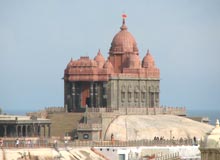 Located in the midst of the ocean, just 400 meters from Kanyakumari, is the magnificent Vivekananda Rock Memorial. This colossal structure was built in the year 1970, under the guidance of Shri Eknath Ranade. The Vivekananda rock temple is dedicated to one of the greatest spiritual philosophers of India, Swami Vivekananda. It is said that Swami Vivekananda meditated here before setting out on one of the most crucial religious campaigns in India in 1892. The idea of building Vivekananda Memorial Rock temple was conceptualized on his birth centenary in the year 1962.
Located in the midst of the ocean, just 400 meters from Kanyakumari, is the magnificent Vivekananda Rock Memorial. This colossal structure was built in the year 1970, under the guidance of Shri Eknath Ranade. The Vivekananda rock temple is dedicated to one of the greatest spiritual philosophers of India, Swami Vivekananda. It is said that Swami Vivekananda meditated here before setting out on one of the most crucial religious campaigns in India in 1892. The idea of building Vivekananda Memorial Rock temple was conceptualized on his birth centenary in the year 1962. 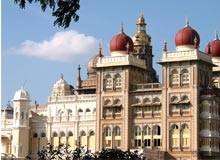 One of the largest palaces in India, Mysore Palace of Karnataka is a fine example of unique blend of different styles of architecture. The Mysore Palace is one of the most attractive and gorgeous monuments in Karnataka. It is also known by the name of Amba Vilas and was the residence of Wodeyar Maharaja. The Mysore Palace was rebuilt in 1912 after the original palace was destroyed in a fire accident in the year 1897. It was re-designed in Saracenic style by a famous British architect Henry Irwin. One can see the blend of different forms of architecture and design in the Maysore Palace.
One of the largest palaces in India, Mysore Palace of Karnataka is a fine example of unique blend of different styles of architecture. The Mysore Palace is one of the most attractive and gorgeous monuments in Karnataka. It is also known by the name of Amba Vilas and was the residence of Wodeyar Maharaja. The Mysore Palace was rebuilt in 1912 after the original palace was destroyed in a fire accident in the year 1897. It was re-designed in Saracenic style by a famous British architect Henry Irwin. One can see the blend of different forms of architecture and design in the Maysore Palace. 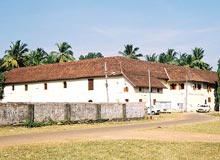 Located at a distance of 10 kilometers from Ernakulam city, Cochin, Mattancherry Palace is a storehouse of ancient paintings and art forms. The Mattancherry Palace came to be known as the Dutch Palace after the Dutch carried out some renovation and extension work. This palace was built by the Portuguese in 1555 A.D. and was then given as a present to the Maharaja of Kochi, Veera Kerala Varma. This palace of Kerala has now been converted into an art gallery showcasing some of the best paintings and murals of Hindu mythology. Read about Mattancherry Palace, which is an important monument in south India.
Located at a distance of 10 kilometers from Ernakulam city, Cochin, Mattancherry Palace is a storehouse of ancient paintings and art forms. The Mattancherry Palace came to be known as the Dutch Palace after the Dutch carried out some renovation and extension work. This palace was built by the Portuguese in 1555 A.D. and was then given as a present to the Maharaja of Kochi, Veera Kerala Varma. This palace of Kerala has now been converted into an art gallery showcasing some of the best paintings and murals of Hindu mythology. Read about Mattancherry Palace, which is an important monument in south India. 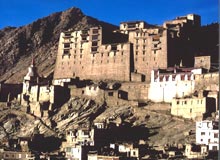 Leh Palace of Ladakh, though in a dilapidated condition continues to lure tourists from far and wide. Located in the Himalayas, the adventurous journey one has to undertake to reach the palace is what makes it even more special. Leh palace was built in the 17th century by King Singe Namgyal as the royal residence. It was deserted in the mid 19th century after the family shifted to Stok. The Leh Palace of Ladakh still retains an old worldly charm about it.
Leh Palace of Ladakh, though in a dilapidated condition continues to lure tourists from far and wide. Located in the Himalayas, the adventurous journey one has to undertake to reach the palace is what makes it even more special. Leh palace was built in the 17th century by King Singe Namgyal as the royal residence. It was deserted in the mid 19th century after the family shifted to Stok. The Leh Palace of Ladakh still retains an old worldly charm about it. 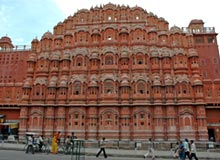 Jaipur is synonymous with Hawa Mahal. This beautiful monument of India was built by Maharaja Sawai Pratap Singh in the year 1799. Also known as the Palace of Winds, this beautiful monument is the landmark of Jaipur. The monument is five stories high and the front of the monument is delicately carved with beautiful motifs. It provides an outstanding example of Rajput style of architecture. Hawa Mahal is not exactly a palace but a screen of superbly sculpted windows that look like the front of a palace. It was built for the royal ladies of Rajasthan who wanted to view the busy city life from inside a veil. Read on about
Jaipur is synonymous with Hawa Mahal. This beautiful monument of India was built by Maharaja Sawai Pratap Singh in the year 1799. Also known as the Palace of Winds, this beautiful monument is the landmark of Jaipur. The monument is five stories high and the front of the monument is delicately carved with beautiful motifs. It provides an outstanding example of Rajput style of architecture. Hawa Mahal is not exactly a palace but a screen of superbly sculpted windows that look like the front of a palace. It was built for the royal ladies of Rajasthan who wanted to view the busy city life from inside a veil. Read on about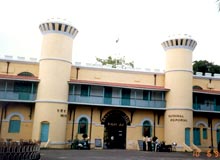 The one name that sends chills down the spine even today is that of Kala Pani Jail, located in Andaman. The jail still has the fear element in the air and anyone visiting the place can sense the pain the inmates went through back during the time this jail was functional. The British undertook the construction of the Cellular Jail and would send "dangerous" criminals from India to this place to undergo torturous treatments. The Andaman Island was used to house prisoners way back in the year 1857. The Cellular Jail of Andaman Island is now a protected monument and stands as a testimony to the torture meted out to the helpless prisoners.
The one name that sends chills down the spine even today is that of Kala Pani Jail, located in Andaman. The jail still has the fear element in the air and anyone visiting the place can sense the pain the inmates went through back during the time this jail was functional. The British undertook the construction of the Cellular Jail and would send "dangerous" criminals from India to this place to undergo torturous treatments. The Andaman Island was used to house prisoners way back in the year 1857. The Cellular Jail of Andaman Island is now a protected monument and stands as a testimony to the torture meted out to the helpless prisoners. 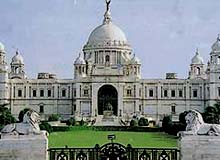 The Victoria Memorial was built to commemorate the peak of the British Empire in India. The Victoria Memorial, conceived by Lord Curzon, represents the architectural climax of
The Victoria Memorial was built to commemorate the peak of the British Empire in India. The Victoria Memorial, conceived by Lord Curzon, represents the architectural climax of 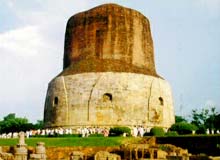 Dhamekh Stupa at Sarnath is one of the prominent Buddhist structures in India. Dhamekh Stupa was constructed by the great Mauryan king, Ashoka. The Dhamekh Stupa is cylindrical in shape and about 34 m high and 28.3 m in diameter. The lower portion of the Stupa is covered completely with beautifully carved stones. The borders of Dhamekh Stupa have delicately carved geometrical and floral designs and figures of humans and birds. The base of the Stupa is made of stone with the upper areas of brickwork which probably once had a carved stone fencing. It is believed that Lord Buddha delivered his first sermon at the Dhamekha Stupa. Dhamekh Stupa bears special significance at Sarnath as it signifies the "seat of the holy Buddha", as he proclaimed his faith.
Dhamekh Stupa at Sarnath is one of the prominent Buddhist structures in India. Dhamekh Stupa was constructed by the great Mauryan king, Ashoka. The Dhamekh Stupa is cylindrical in shape and about 34 m high and 28.3 m in diameter. The lower portion of the Stupa is covered completely with beautifully carved stones. The borders of Dhamekh Stupa have delicately carved geometrical and floral designs and figures of humans and birds. The base of the Stupa is made of stone with the upper areas of brickwork which probably once had a carved stone fencing. It is believed that Lord Buddha delivered his first sermon at the Dhamekha Stupa. Dhamekh Stupa bears special significance at Sarnath as it signifies the "seat of the holy Buddha", as he proclaimed his faith.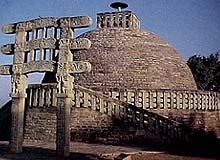 Sanchi is famous for outstanding specimen of
Sanchi is famous for outstanding specimen of 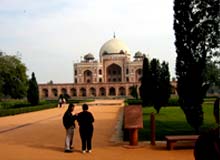 Safdarjung's tomb was built by Nawab Shuja-ud-Daulah, the son of Safdarjung. Safdarjung was the governor of Awadh and later became the Prime Minister of Muhammad Shah, the Mughal emperor. Built in 1753-1754, the Safdarjung tomb lies at the Lodi road, New Delhi. Safdarjung's tomb is set in the middle of a garden, which spreads over an area of 300 sq m. The garden of Safdarjung's tomb is laid down on the pattern of the Mughal Charbagh style. The Safdarjung tomb was erected roughly on the pattern of Humayun's tomb.
Safdarjung's tomb was built by Nawab Shuja-ud-Daulah, the son of Safdarjung. Safdarjung was the governor of Awadh and later became the Prime Minister of Muhammad Shah, the Mughal emperor. Built in 1753-1754, the Safdarjung tomb lies at the Lodi road, New Delhi. Safdarjung's tomb is set in the middle of a garden, which spreads over an area of 300 sq m. The garden of Safdarjung's tomb is laid down on the pattern of the Mughal Charbagh style. The Safdarjung tomb was erected roughly on the pattern of Humayun's tomb. 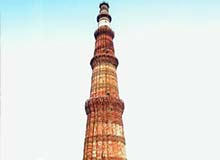 Qutub Minar is the highest stone tower in India. The construction of the Qutub Minar was started by Qutub-ud-Din Aibak in 1199 and it was finished by his successor and son-in-law, Iltutmish. The Qutub Minar was named after the Sufi saint, Khwaja Qutubuddin Bakhtiyar Kaki. Though the exact purpose of the Qutb Minar is not known but it is believed that it served as a minaret to the adjoining mosque and was used by the muezzins to call the faithful to prayer.
Qutub Minar is the highest stone tower in India. The construction of the Qutub Minar was started by Qutub-ud-Din Aibak in 1199 and it was finished by his successor and son-in-law, Iltutmish. The Qutub Minar was named after the Sufi saint, Khwaja Qutubuddin Bakhtiyar Kaki. Though the exact purpose of the Qutb Minar is not known but it is believed that it served as a minaret to the adjoining mosque and was used by the muezzins to call the faithful to prayer. 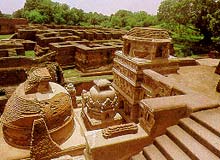 Nalanda was a great center of Buddhist learning in ancient times. A large number of Buddhist students thronged the Nalanda University to study Buddhism. According to the Chinese traveler Hieun Tsang, the place owed its name to a Naga, who resided in a local tank. Lord Vardhamana Mahavir and Lord Buddha visited Nalanda quite frequently in the 6th century BC. Nalanda is also supposed to the birth place of one Sariputra, one of the chief followers of Lord Buddha.
Nalanda was a great center of Buddhist learning in ancient times. A large number of Buddhist students thronged the Nalanda University to study Buddhism. According to the Chinese traveler Hieun Tsang, the place owed its name to a Naga, who resided in a local tank. Lord Vardhamana Mahavir and Lord Buddha visited Nalanda quite frequently in the 6th century BC. Nalanda is also supposed to the birth place of one Sariputra, one of the chief followers of Lord Buddha. 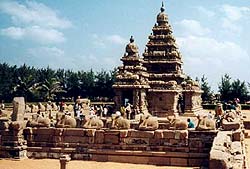 Famous as temple town, Mahabalipuram is situated along the shores of the Bay of Bengal about 60 km from the south of Chennai. Mahabalipuram is home to one of the architectural wonders of the world, the Ratha temples. It was the Pallava king Narsimha, who built the magnificent 'Ratha' cave temples of Mahabalipuram in the 7th century. The Ratha temples at Mahabalipuram bear testimony to the artistic genius of Indian architects in ancient times. The Ratha temples also reflect the artistic tastes of the Pallava rulers. The Ratha temples gave birth to a new style of architecture, the South Indian temple architecture.
Famous as temple town, Mahabalipuram is situated along the shores of the Bay of Bengal about 60 km from the south of Chennai. Mahabalipuram is home to one of the architectural wonders of the world, the Ratha temples. It was the Pallava king Narsimha, who built the magnificent 'Ratha' cave temples of Mahabalipuram in the 7th century. The Ratha temples at Mahabalipuram bear testimony to the artistic genius of Indian architects in ancient times. The Ratha temples also reflect the artistic tastes of the Pallava rulers. The Ratha temples gave birth to a new style of architecture, the South Indian temple architecture. 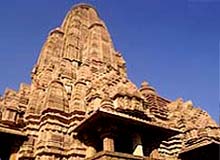 Known for their breathtaking sculptors and
Known for their breathtaking sculptors and 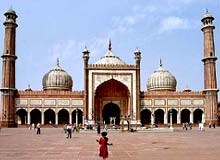 Jama Masjid of Delhi is the largest mosque in India. The Jama Masjid stands across the road in front of the Red Fort. Built between 1644 and 1658, Jama Masjid is one of the last
Jama Masjid of Delhi is the largest mosque in India. The Jama Masjid stands across the road in front of the Red Fort. Built between 1644 and 1658, Jama Masjid is one of the last 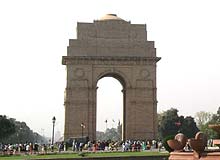 India Gate, situated on the Raj Path in New Delhi, was built to memorialize the 70,000 Indian soldiers who lost their lives during the
India Gate, situated on the Raj Path in New Delhi, was built to memorialize the 70,000 Indian soldiers who lost their lives during the 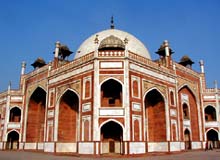 After wandering in wilderness for 25 years, Humayun reoccupied Delhi in the year 1555 AD but he was not destined to rule any longer and died barely six months of his arrival, from a fall in his library, Sher Mandal. Humayun's tomb was built by his widow, Hajji Begum around 1565 AD. The Taj Mahal and many other Mughal buildings are said to have been inspired from Humayun's tomb. Humayun's tomb is one of the world heritage sites. The tomb of Humayun is based on Islamic paradise gardens. This type of garden is known as a Charbagh and is based on a grid system. The square garden is divided into four large squares and separated by causeways and channels with each square again divided into smaller squares.
After wandering in wilderness for 25 years, Humayun reoccupied Delhi in the year 1555 AD but he was not destined to rule any longer and died barely six months of his arrival, from a fall in his library, Sher Mandal. Humayun's tomb was built by his widow, Hajji Begum around 1565 AD. The Taj Mahal and many other Mughal buildings are said to have been inspired from Humayun's tomb. Humayun's tomb is one of the world heritage sites. The tomb of Humayun is based on Islamic paradise gardens. This type of garden is known as a Charbagh and is based on a grid system. The square garden is divided into four large squares and separated by causeways and channels with each square again divided into smaller squares. 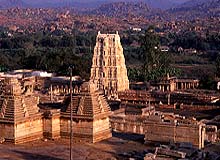 Hampi was the capital of Vijayanagar Empire, the last great Hindu Kingdom. Under the Vijayanagar rulers Hampi grew fabulously. The princes of Vijayanagar built numerous Dravidian temples and palaces. The records of foreign travelers between 14th and 16th century bear testimony to the grandeur of Hampi. However the magnificent capital of Vijayanagar was destroyed by the Deccan Muslim league in 1565. Hampi is a village in northern Karnataka, India. It marks the ruins of Vijayanagar, the former capital of the Vijayanagar Empire. The Hampi village also houses the well-known Virupaksha temple.
Hampi was the capital of Vijayanagar Empire, the last great Hindu Kingdom. Under the Vijayanagar rulers Hampi grew fabulously. The princes of Vijayanagar built numerous Dravidian temples and palaces. The records of foreign travelers between 14th and 16th century bear testimony to the grandeur of Hampi. However the magnificent capital of Vijayanagar was destroyed by the Deccan Muslim league in 1565. Hampi is a village in northern Karnataka, India. It marks the ruins of Vijayanagar, the former capital of the Vijayanagar Empire. The Hampi village also houses the well-known Virupaksha temple. 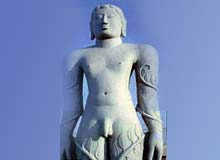 The colossal monolithic statue of Gomateswara is situated at Sravanbelgola, 158 km away from Bangalore. This gigantic statue of lord Gomateswara, the Jain saint, is carved out of a single block of granite and stands majestically on top of a hill. For centuries, Sravanabelagola has remained a great Jain center and thousands of
The colossal monolithic statue of Gomateswara is situated at Sravanbelgola, 158 km away from Bangalore. This gigantic statue of lord Gomateswara, the Jain saint, is carved out of a single block of granite and stands majestically on top of a hill. For centuries, Sravanabelagola has remained a great Jain center and thousands of 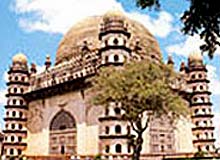 Gol Gumbad situated in Bijapur district of Karnataka is the second largest dome in the world. The Gol Gumbad is second in size only to St. Peter's Basilica, Rome. The Gol Gumbad is 124 feet in diameter. The architecture of Gol Gumbad is unique in the sense that the four minarets themselves are the staircases, leading to the top dome. Gol Gumbad is truly an amazing architectural wonder as the dome stands unsupported by pillars. The most fascinating and remarkable feature of the Gol Gumbad is its acoustical system. Even the faintest whisper around the dome echoes several times. The gallery around the dome of the Gol Gumbad provides a wonderful view of the town.
Gol Gumbad situated in Bijapur district of Karnataka is the second largest dome in the world. The Gol Gumbad is second in size only to St. Peter's Basilica, Rome. The Gol Gumbad is 124 feet in diameter. The architecture of Gol Gumbad is unique in the sense that the four minarets themselves are the staircases, leading to the top dome. Gol Gumbad is truly an amazing architectural wonder as the dome stands unsupported by pillars. The most fascinating and remarkable feature of the Gol Gumbad is its acoustical system. Even the faintest whisper around the dome echoes several times. The gallery around the dome of the Gol Gumbad provides a wonderful view of the town. 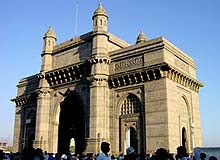 One of the grand and magnificent landmarks of Mumbai, the Gateway of India was built to commemorate the visit of the British Monarch, King George V and Queen Mary. The Gateway of India is one of the hot spots of Mumbai city. The Gateway of India is a massive archway on the Apollo Bunder. For most of the tourists and travelers, the Gateway of India is the starting point to explore the Mumbai city. The Gateway of India was designed by the architect George Wittet. The first stone of the Gateway of India was laid on March 31st 1913. The foundations were completed in 1920 and the Gateway of India was formally opened in 1924 by the then Viceroy, Earl of Reading.
One of the grand and magnificent landmarks of Mumbai, the Gateway of India was built to commemorate the visit of the British Monarch, King George V and Queen Mary. The Gateway of India is one of the hot spots of Mumbai city. The Gateway of India is a massive archway on the Apollo Bunder. For most of the tourists and travelers, the Gateway of India is the starting point to explore the Mumbai city. The Gateway of India was designed by the architect George Wittet. The first stone of the Gateway of India was laid on March 31st 1913. The foundations were completed in 1920 and the Gateway of India was formally opened in 1924 by the then Viceroy, Earl of Reading. 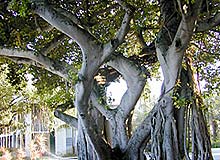 Banyan is the National tree of India. The mighty banyan tree commands a great presence in the rural setting of India. The very size of the banyan tree makes it a habitat for a large number of creatures. For centuries the banyan tree has been a central point for the village communities of India.
Banyan is the National tree of India. The mighty banyan tree commands a great presence in the rural setting of India. The very size of the banyan tree makes it a habitat for a large number of creatures. For centuries the banyan tree has been a central point for the village communities of India. 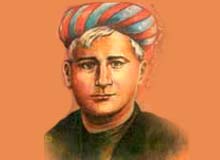 The National song of India is Vande Mataram. It was composed by the famous poet, Bankim Chandra Chaterjee in the year 1875. Rabindranath sang the National song (Vande Mataram) by setting a magnificent tune and Shri Aurobindo interpreted the deep meaning of the song. The English translation of Vande Mataram (National song) was rendered by Aurobindo, which is considered official.
The National song of India is Vande Mataram. It was composed by the famous poet, Bankim Chandra Chaterjee in the year 1875. Rabindranath sang the National song (Vande Mataram) by setting a magnificent tune and Shri Aurobindo interpreted the deep meaning of the song. The English translation of Vande Mataram (National song) was rendered by Aurobindo, which is considered official.  Hockey is the National Game of India. Hockey has been played in India for time immemorial. There was a golden period of Indian hockey when hockey stalwarts of India ruled the game. On the international scenario there were no competitors to match the magical hands of Indian
Hockey is the National Game of India. Hockey has been played in India for time immemorial. There was a golden period of Indian hockey when hockey stalwarts of India ruled the game. On the international scenario there were no competitors to match the magical hands of Indian 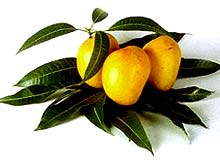 Mango (Mangifera Indica) is the National fruit of India. Mango is one of the most widely grown fruits of the tropical countries. In India, mango is cultivated almost in all parts, with the exception of hilly areas. Mango is a rich source of Vitamins A, C and D. In India, we have hundreds of varieties of mangoes. They are of different sizes, shapes and colors. Mangoes have been cultivated in India since time immemorial. Even in our mythology and history there are stories of mangoes- the famous Indian poet Kalidasa sang its praise. Alexander the great, along with Hieun Tsang savored the taste of mangoes. The great Mughal king, Akbar is said to have planted over 100,000 mango trees in Darbhanga (modern Bihar). The mango is eaten ripe and is also used for pickles.
Mango (Mangifera Indica) is the National fruit of India. Mango is one of the most widely grown fruits of the tropical countries. In India, mango is cultivated almost in all parts, with the exception of hilly areas. Mango is a rich source of Vitamins A, C and D. In India, we have hundreds of varieties of mangoes. They are of different sizes, shapes and colors. Mangoes have been cultivated in India since time immemorial. Even in our mythology and history there are stories of mangoes- the famous Indian poet Kalidasa sang its praise. Alexander the great, along with Hieun Tsang savored the taste of mangoes. The great Mughal king, Akbar is said to have planted over 100,000 mango trees in Darbhanga (modern Bihar). The mango is eaten ripe and is also used for pickles.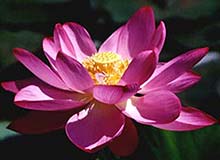 Lotus is the National flower of India. The Lotus symbolizes spirituality, fruitfulness, wealth, knowledge and illumination. The most important thing about lotus is that even after growing in murky water it is untouched by its impurity. On the other hand the lotus symbolizes purity of heart and mind. The National Flower 'Lotus' or water lily is an aquatic plant of Nymphaea species with broad floating leaves and bright aromatic flowers that grow only in shallow waters.
Lotus is the National flower of India. The Lotus symbolizes spirituality, fruitfulness, wealth, knowledge and illumination. The most important thing about lotus is that even after growing in murky water it is untouched by its impurity. On the other hand the lotus symbolizes purity of heart and mind. The National Flower 'Lotus' or water lily is an aquatic plant of Nymphaea species with broad floating leaves and bright aromatic flowers that grow only in shallow waters. 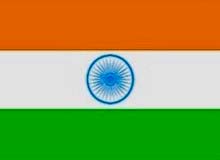 The national flag of India is tricolor. It has deep saffron color strip at the top, white in the middle and dark green at the bottom in equal proportions. The width and length ratio of the National flag is two is to three. In the centre of the white strip, there is a wheel in navy blue color to indicate the Dharma Chakra, the wheel of law in the Sarnath Lion Capital. The diameter of the wheel approximates to the width of the white strip and has 24 spokes. The design of the national flag was adopted by the Constituent Assembly of India on 22nd July, 1947. The use and display of the National flag of India are regulated by a flag Code.
The national flag of India is tricolor. It has deep saffron color strip at the top, white in the middle and dark green at the bottom in equal proportions. The width and length ratio of the National flag is two is to three. In the centre of the white strip, there is a wheel in navy blue color to indicate the Dharma Chakra, the wheel of law in the Sarnath Lion Capital. The diameter of the wheel approximates to the width of the white strip and has 24 spokes. The design of the national flag was adopted by the Constituent Assembly of India on 22nd July, 1947. The use and display of the National flag of India are regulated by a flag Code.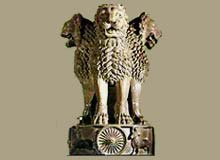 The National Emblem of India has been taken from the Sarnath Lion capital erected by Ashoka. The national emblem of India was adapted by the Government of India on 26th January1950. In the National emblem only three lions are visible and
The National Emblem of India has been taken from the Sarnath Lion capital erected by Ashoka. The national emblem of India was adapted by the Government of India on 26th January1950. In the National emblem only three lions are visible and 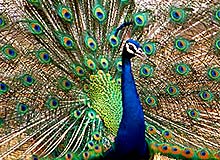 Peacock (Pavo cristatus), which is a symbol of grace, joy, beauty and love is the national bird of India. Peacock occupies a respectable position in Indian culture and is protected not only by religious sentiments but also by parliamentary statute. The Indian peacock is a colorful, swan-sized bird with a fan-shaped crest of feathers on its head, a white patch under the eye and a long-slender neck. The male peacock is more colorful than the female one.
Peacock (Pavo cristatus), which is a symbol of grace, joy, beauty and love is the national bird of India. Peacock occupies a respectable position in Indian culture and is protected not only by religious sentiments but also by parliamentary statute. The Indian peacock is a colorful, swan-sized bird with a fan-shaped crest of feathers on its head, a white patch under the eye and a long-slender neck. The male peacock is more colorful than the female one. 